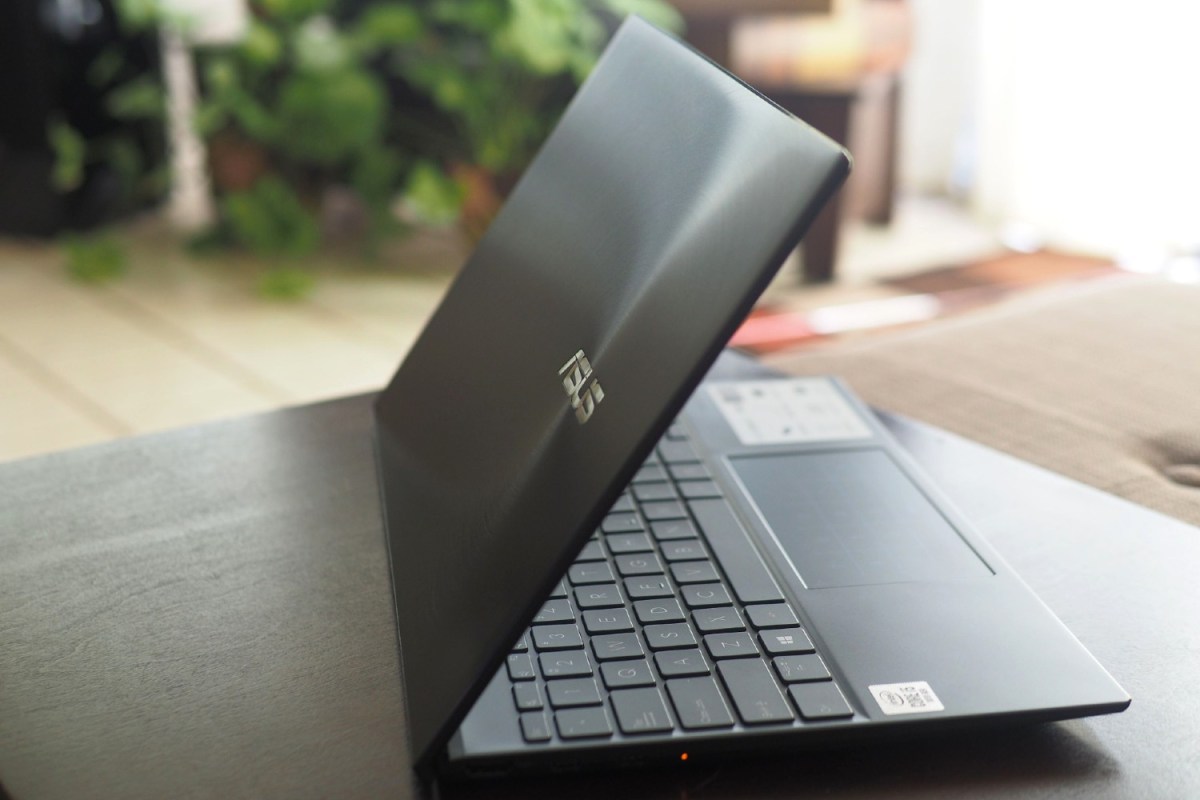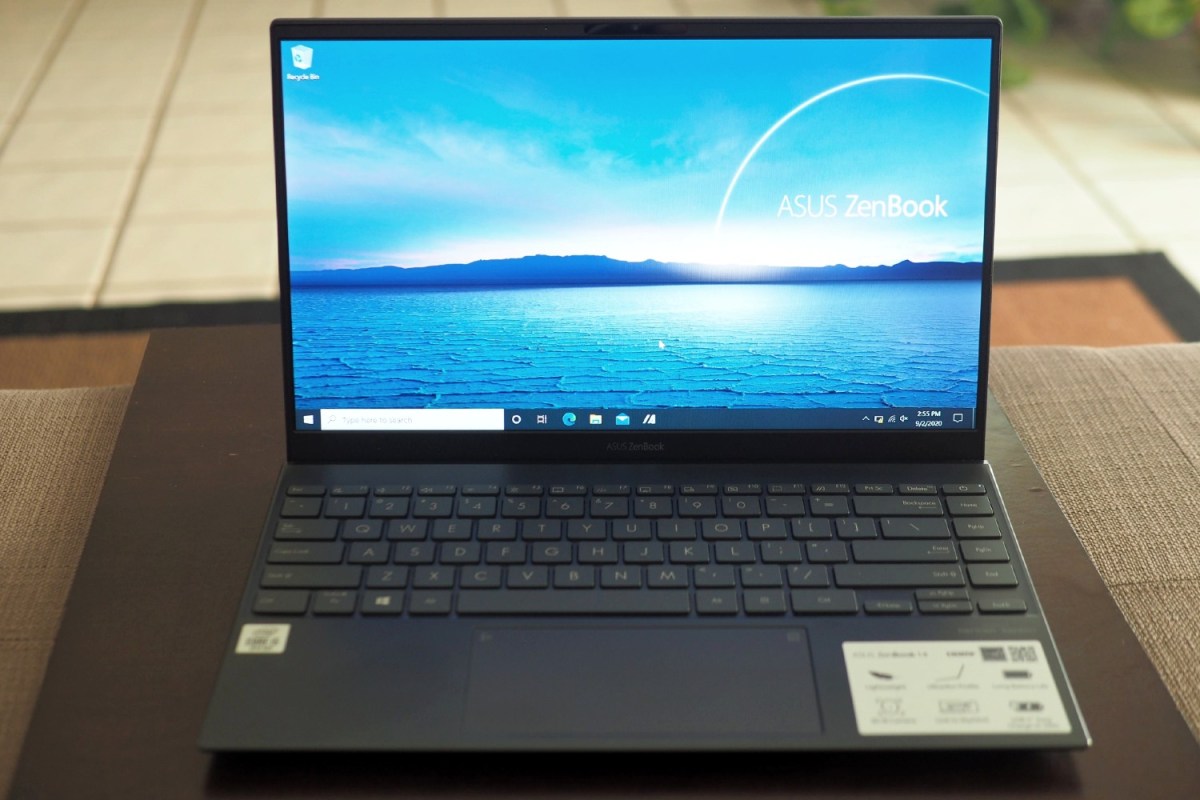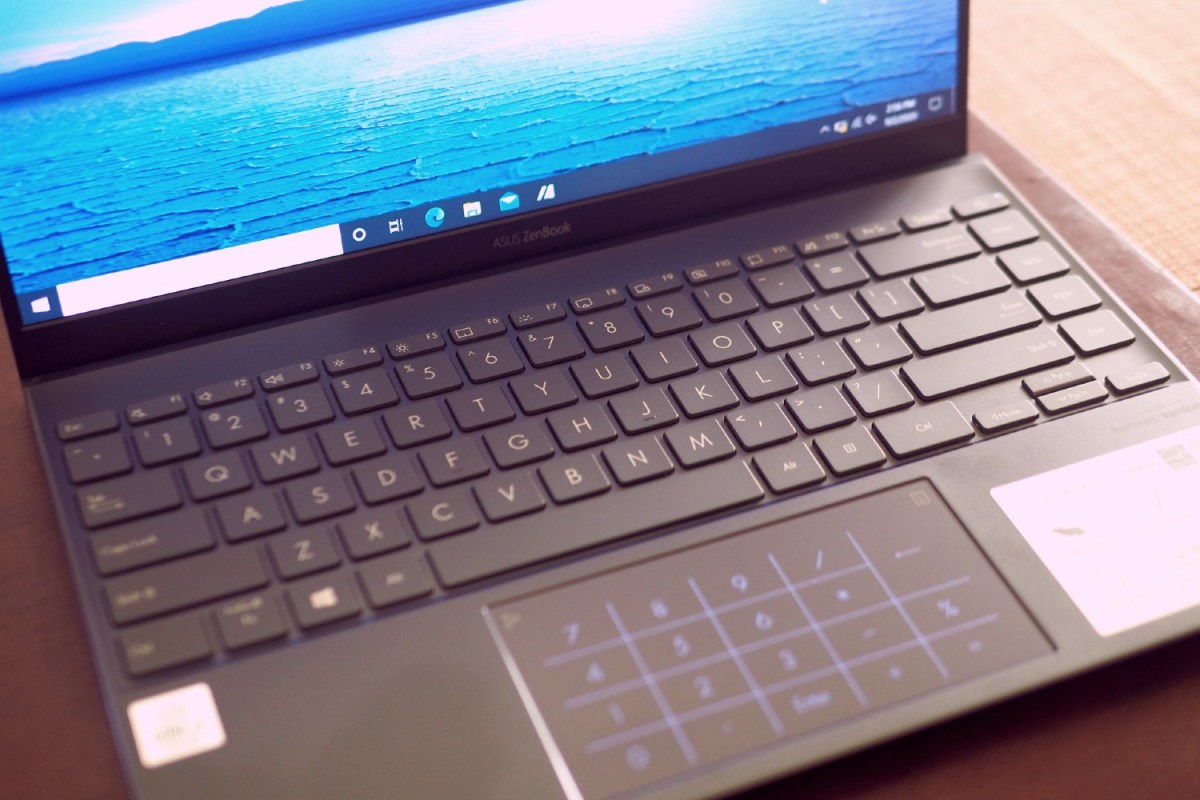- Solid build quality
- Elegant design
- Useful keyboard and touchpad
- Great battery life
- Incredible value
- No headphone jack
- Lacks a touchscreen option
Asus has a mind-boggling amount of ZenBook models, and not all of them stand out.
The last Asus ZenBook 14 we reviewed, the UX433 model, was one of those. It lacked some features that set it behind — like no Thunderbolt 3 ports, unforgivable in a premium laptop — and was average in several areas where the competition excels. This year, Asus quietly rolled out the ZenBook 14 UX425 model, which adds some missing features and makes some noticeable improvements across the board — all while dropping the price.
I reviewed a model with a 10th-generation Intel Ice Lake Core i5-1035G1 CPU, 8GB of RAM, a 512GB solid-state drive (SSD), and a 14-inch Full HD (1,920 x 1,080) IPS low-power display that uses just one watt of power, half the usual two watts. What’s rather striking is that this configuration retails for only $800 — add $100, and you get a Core i7-1065G7 with Iris Plus Graphics. Did Asus make enough improvements to elevate the ZenBook 14 among its peers, especially given such a low price?
Design

Asus has been working hard for a couple of years now to make laptops that leverage small bezels to fit into smaller chassis. In that spirit, the ZenBook 14 UX425 is smaller than its predecessor, the UX434, in almost all dimensions thanks to the 90% screen-to-body ratio. It’s the same width, but it’s slightly less deep, and it’s now just 0.54 inches thick compared to 0.67 inches. It also comes in at 2.58 pounds compared to 2.98 pounds.
Clearly, the focus of the UX425 model is on being thin and light rather than packing in some of the more powerful features of the UX434 such as a low-end discrete GPU. The miniaturization puts the ZenBook 14 in good company; for example, it’s not far off the LG Gram 14‘s 2.2 pounds — and that’s a laptop explicitly engineered to be as light as possible. The ZenBook 14’s competition will likely include more popular 13-inch laptops like the Dell XPS 13, and it’s thinner than the XPS 13 (0.57 inches) and lighter (2.65 pounds). That’s impressive for a 14-inch laptop.
Asus didn’t skimp on the build quality, either. The ZenBook 14 enjoys an all-aluminum chassis that feels quite robust and passed through a gauntlet of military certification tests. I could pick some nits, of course. The lid is a bit bendy, and the keyboard has a smidgen of flex to it. But overall, the laptop feels solid despite being so light.
The hinge is also perfect, easy to open with one hand and yet it holds the display in place. Kudos to Asus for engineering a laptop that feels like it earns a premium price, even though it falls close to budget territory.
Aesthetically, the ZenBook 14 looks a lot like … well … a ZenBook. That’s on purpose — Asus is as serious about creating a consistent look to its ZenBooks as Lenovo is about its ThinkPad line. You’ll find the iconic Asus concentric swirl on the lid with the Asus logo on the right side at the center of the circles.
Otherwise, the laptop is simply but deftly designed and comes across to my eyes as quite elegant. Again, Asus shows off its design chops, and the ZenBook 14 competes well in the looks department. My review unit was the pine gray color, but there’s also a lilac mist available.

Connectivity would be excellent if it weren’t for one glaring omission. You’ll find a full-size HDMI 2.0 port on the left side of the laptop to go with two USB-C ports with Thunderbolt 3 support. That’s huge — previous ZenBooks skipped Thunderbolt 3, and it was a glaring faux pas compared to other premium laptops. At $800, it’s even more impressive. On the right side, you’ll find a USB-A 3.2 port and a microSD card reader (too bad it’s not a full-size version). Wireless connectivity is up to date, with Wi-Fi 6 and Bluetooth 5.0 on board.
So, what’s the omission? Asus had to make some room given the laptops thin frame, and the company had a choice between dropping the HDMI port or the 3.5mm audio jack. Apparently, customers they polled preferred the HDMI port and the audio jack was left out.
There’s a USB-C to 3.5mm dongle included in the box, but to my mind, that was a huge mistake. When you have two Thunderbolt 3 connections, adding an external monitor — or, with a dock, multiple monitors — is trivial. But, taking up one of the ports just to plug in some headphones or speakers? Sorry, Asus, that doesn’t make sense to me.
Performance
The Asus ZenBook 14 UX425 uses 10th-gen Ice Lake Intel CPUs, and my review unit was equipped with the Core i5-1035G1. That’s a midrange 15-watt processor that should provide solid productivity performance but shouldn’t be looked at for demanding creative tasks.
In my testing, it performed relatively better on synthetic benchmarks than on real-world tests. For example, in Geekbench 5, the ZenBook 14 scored 1,209 on the single-core test and 4,321 on the multi-core test. That’s fast for the CPU, beating out laptops like the Acer Spin 3 that scored 1,215 and 3,615 and the Acer Aspire 5 that score 1,129 and 2,899.
The ZenBook 14 lags behind in performance in certain content creation tasks.
However, in our Handbrake test that converts a 420MB video to H.265, the ZenBook 14 required almost five and a half minutes to complete the test. The Acer Spin 3 finished in just over four minutes, and the Acer Aspire 5 finished 15 seconds faster. I was surprised it performed so poorly on this test — the rear edge and vents prop up just a bit when you open the lid, which should improve airflow and allow for better-sustained performance. But even so, the ZenBook 14 lags behind in certain content creation tasks.
That doesn’t mean it’s not a good performer for its targeted productivity tasks. If you don’t run demanding creative tasks, then you’ll find the ZenBook 14 to be plenty quick.
Don’t expect to do any real gaming, though. The laptop equips the entry-level Intel UHD graphics, which should be limited to older and e-sports titles at lower resolutions and graphical detail. You’ll want to bump up to the Core i7 model with its Iris Plus graphics to do some light gaming.
Display

So far, the design and performance have been top-notch for an $800 laptop. Next up is the display, one component that companies sometimes skimp on to squeeze under a particular price.
In the case of the ZenBook 14, Asus did no such thing. This would be a very good display for a premium laptop, and it’s an excellent display for its midrange price. It’s average (for premium laptops) in only one area: The color gamut is 94% of sRGB and 72% of AdobeRGB. Those are wide enough colors for productivity and multimedia uses, and only creative pros would find them disappointing.
Moving on from there, though, the display is above the premium average. Brightness is relatively high at 352 nits, well above our preferred 300-nit threshold. Contrast comes in at 1,060:1, exceeding our preferred 1,000:1 ratio and much higher than the 800:1 or so average you’ll find on most premium productivity machines. Color accuracy is very good at 1.42 (1.0 or less is considered excellent), and gamma is spot on at 2.2.
I enjoyed using the display while writing this review — text popped, colors were bright and not oversaturated, and there was plenty of brightness no matter where I worked (except under direct sunlight, of course). I’d be happy with this display in a laptop costing twice as much as the ZenBook 14.
This display is much better than the one you’ll find on the LG Gram 14 2-in-1, and while it can’t match the Dell XPS 13’s Full HD display, it’s not far off — and the ZenBook 14 is hundreds of dollars less expensive.
Keyboard and touchpad

One of my favorite keyboards adorns HP’s Spectre line and some recent Envy models. It has large keys with plenty of spacing, ample travel, and a light mechanism that still provides a clicky, precise feel. Why do I mention HP’s keyboard? Because the one that Asus built into the ZenBook 14 looks and feels remarkably similar. It even has the same row of Home, PgUp, PgDn, and End keys along the right edge.
I’m not saying Asus copied HP on purpose, but whatever — it’s an excellent keyboard that comes close to matching HP’s version. I’d say I like it almost as much, although the Asus iteration is just a little too light with its touch.
The touchpad is another standout feature of the ZenBook 14. It’s significantly wider this time around, making it quite large for this size of chassis in a Windows 10 machine. More importantly, it has a smooth and comfortable glass surface for accurate tracking and clicking. Of course, it features Windows Precision drivers, which make multitouch gestures and general swiping a dream.
Asus remains stubborn regarding adding touch displays to its clamshell laptops.
But most notable is the NumberPad 2.0 feature, which embeds an LED number pad in the touchpad that’s quite useful for anyone who needs to input numbers. You can turn the NumberPad on and off simply enough by touching and briefly holding an icon on the upper right of the touchpad and change its brightness by touching and holding an icon on the upper left. Turning the NumberPad on doesn’t interfere with using the touchpad as a touchpad, which is a good thing.
Asus remains stubborn regarding adding touch displays to its clamshell laptops, though. There’s no option for one with the ZenBook 14, and that’s a pet peeve of mine. I hate using a laptop without a touch display — I’m too used to using my thumb to scroll web pages and to tapping buttons that pop up without needing to engage the touchpad. I might be in the minority here, though, so perhaps Asus has simply decided it’s not worth the added weight and thickness for a (theoretically) small number of users who would want the feature.
Windows Hello password-less support is provided by an infrared camera and facial recognition. It works quickly and precisely, and though I prefer a fingerprint reader — which the ZenBook 14 does not have — it’s a useful feature.
Battery life

Asus increased the ZenBook 14 UX425’s battery capacity in this generation, from 50 to 67 watt-hours of capacity. That’s huge. As mentioned earlier, the display is also a low-power 1-watt version, which in our experience typically results in excellent battery life. I was hopeful that the ZenBook 14 would follow suit.
As it turns out, the ZenBook 14 did very well in our suite of tests, even if it didn’t quite match some other laptops with low-power displays. It managed over four hours in our most demanding Basemark web benchmark test, which is a solid score and the one that’s most affected by the CPU and GPU and least affected by the display. Compared to another strong 14-inch performer, the LG Gram 14 2-in-1 with 72 watt-hours of battery life, it lost by a mere minute. The Dell XPS 13 lasted for about 20 minutes longer.
In terms of battery life, the ZenBook 14 is an all-day performer and then some.
It’s in our next two tests, though, that the ZenBook 14 stood out. First, it made it to 11 hours on our web browsing test, a strong score that lagged the LG Gram 14 by 18 minutes and the XPS 13 by about 30 minutes. Then, in our video test that loops a local Full HD Avengers trailer, the ZenBook 14 made it just past 15 hours, compared to the LG Gram 14 at about over 16.5 hours and the XPS 13 at about 12.5 hours.
It’s hard to be disappointed in results like this, although I did expect better given the low-power display. The Dell Latitude 7400 2-in-1 with its low-power panel lasted for a remarkable 21.8 hours on our video test, which is where the display savings make the biggest difference. But even so, the ZenBook 14 is an all-day performer and then some. You can expect to get a full day’s work in and have plenty of battery life left over for some Netflix bingeing that evening.
Our take
At $1,200, I’d say the Asus ZenBook 14 UX425 would be a superior thin and light laptop with a lot to recommend it. At $800, I’m more inclined to call it a steal.
The Asus ZenBook 14 is a great laptop regardless of price, with a solid all-metal build, a refined thin and light design, a great keyboard and useful touchpad, and fantastic battery life. Toss in an $800 price tag, and we’re talking some exceptional value.
Is there a better alternative?
The LG Gram 14 is an option if you want a 14-inch display that approaches the ZenBook 14’s lightness. You’ll pay more money but get similar specifications, and the Gram 14 won’t be nearly as thin. Another 14-inch option you should keep in mind is the Lenovo IdeaPad Slim 7, an AMD Ryzen 4000-based laptop for $100 more that is faster and offers even better battery life.
If you don’t mind dropping down in screen size, then then the Dell XPS 13 is a more expensive alternative. It’s going to perform a little better, its display is a bit higher quality, and it’ll get somewhat better battery life. But it, too, will cost more.
Lastly, if you want to save some money, you could consider the Lenovo Flex 5 14, a 14-inch 2-in-1 running AMD’s Ryzen 4000 CPU. It’s faster and almost as well-built as the ZenBook 14, but it won’t get nearly the battery life. It’s also just $600, offering quite a bit of value of its own.
How long will it last?
The ZenBook 14 UX425 is well-built and configured with the latest technology. It’ll last you for years of productive work. The one-year warranty is disappointing, as usual, but Asus does throw in a year’s worth of accident protection.
Should you buy it?
Yes. If you’re looking for a thin and light laptop for productivity and media consumption, you can’t go wrong with the ZenBook 14. And you won’t spend a lot, either.




